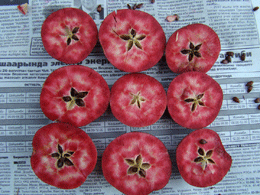Of course it is tiresome for you, Dear Reader, to have to wade through me correcting the mainstream media, but when duty calls I am powerless to refuse.
The BBC was all breathless a couple of days ago with news of a new apple variety on sale in England that has red flesh. Oooh. Ah. It’s like a tomato! And a large chunk of the little report was taken up by the breeder explaining that no GM was involved, just 15 years of crosses and selection and 20,000 seedlings rejected in favour of three that made the grade as worthwhile varieties. 1
 What really struck me, though, was not the utter imbecility of the reporter, or even what the bloody apple looked like. It was the fact that nobody had seemed to ask whether this was in fact the world’s first red-fleshed apple, as reported by FOXNews and The Daily Mail. 2 It isn’t that there are some wild red-fleshed apples out there, and this is the first one that’s good to eat. There have even been a fair number of commercial, good to eat, red-fleshed varieties. It’s just that reporters swallow rubbish so uncomplainingly. Google is your friend.
What really struck me, though, was not the utter imbecility of the reporter, or even what the bloody apple looked like. It was the fact that nobody had seemed to ask whether this was in fact the world’s first red-fleshed apple, as reported by FOXNews and The Daily Mail. 2 It isn’t that there are some wild red-fleshed apples out there, and this is the first one that’s good to eat. There have even been a fair number of commercial, good to eat, red-fleshed varieties. It’s just that reporters swallow rubbish so uncomplainingly. Google is your friend.
The photo (by Kayirkul Shalpykov, Bioresource, and lifted from the Living on Earth website) is of “Niedzwetzky apples (malus niedzwetzkyana), famous for their red flesh. There are 111 known trees left in the world”. Not sure I believe that either.